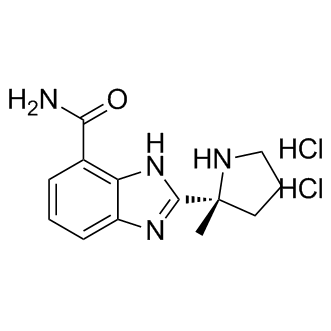| Description: |
Veliparib (dihydrochloride) is a potent inhibitor of PARP1 and PARP2 with Kis of 5.2 nM and 2.9 nM in cell-free assays, respectively. |
| In Vivo: |
The oral bioavailability of Veliparib is 56%-92% in mice, SD rats, beagle dogs, and cynomolgus monkeys after oral administration[1]. Veliparib (25 mg/kg, i.p.) can improve tumor growth delay in a NCI-H460 xenograft model. Combination with radiation, veliparib decreases the tumor vessel formation[3]. Veliparib reduces intratumor PAR levels by more than 95% at a dose of 3 and 12.5 mg/kg in A375 and Colo829 xenograft models and the suppression can be maintained over time[4]. |
| In Vitro: |
Veliparib is inactive to SIRT2 (>5 μM)[1]. Veliparib inhibits the PARP activity with EC50 of 2 nM in C41 cells[2]. Veliparib can decrease the PAR levels in both irradiated and nonirradiated H460 cells. Veliparib reduces clonogenic survival and inhibits DNA repair by PARP-1 inhibition in H460 cells. Veliparib increases apoptosis and autophagy in H460 cells when combination with radiation[3]. Veliparib inhibits PARP activity in H1299, DU145 and 22RV1 cells and the inhibition is independent of p53 function. Veliparib (10 μM) suppresses the surviving fraction (SF) by 43% in the clonogenic H1299 cells. Veliparib shows effective radiosensitivity in oxic H1299 cells. Veliparib can attenuate the SF of hypoxic-irradiated cells including H1299, DU145 and 22RV1[4]. |






















